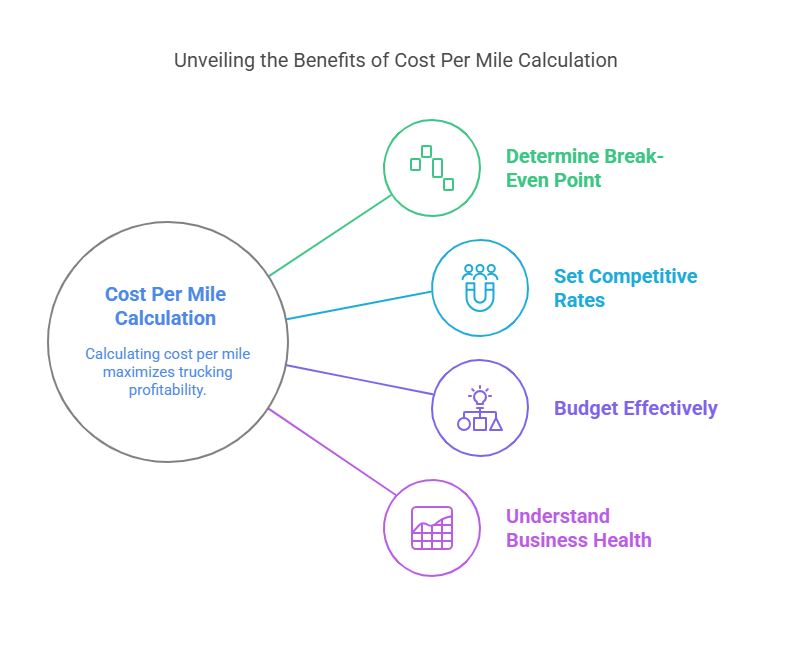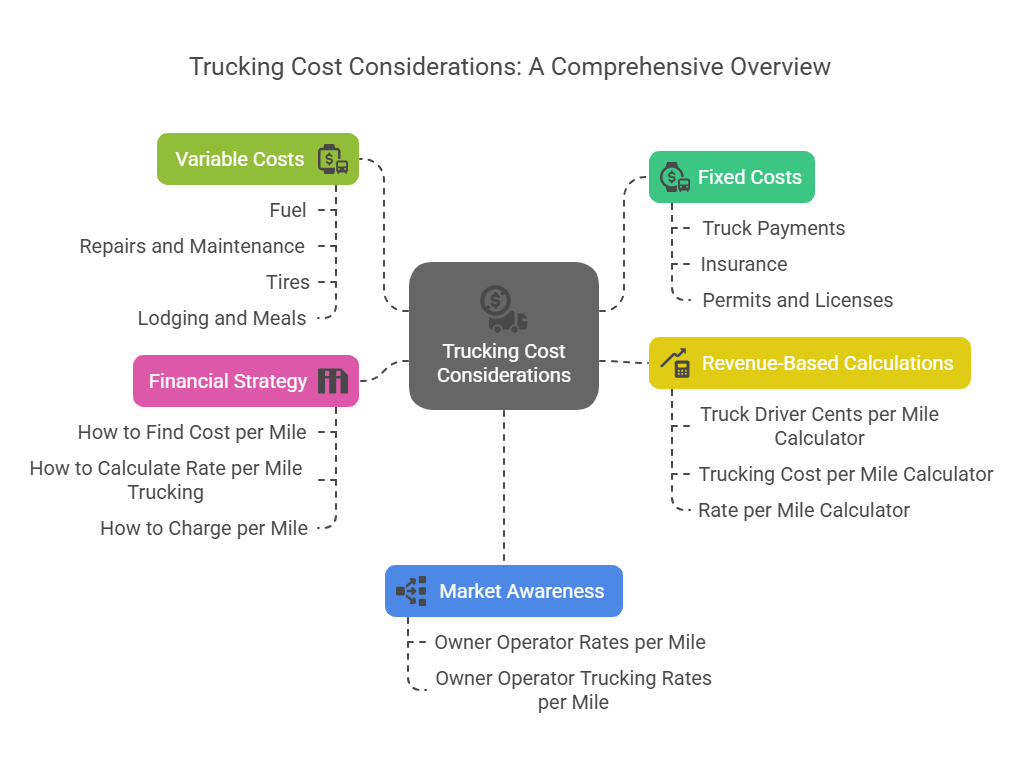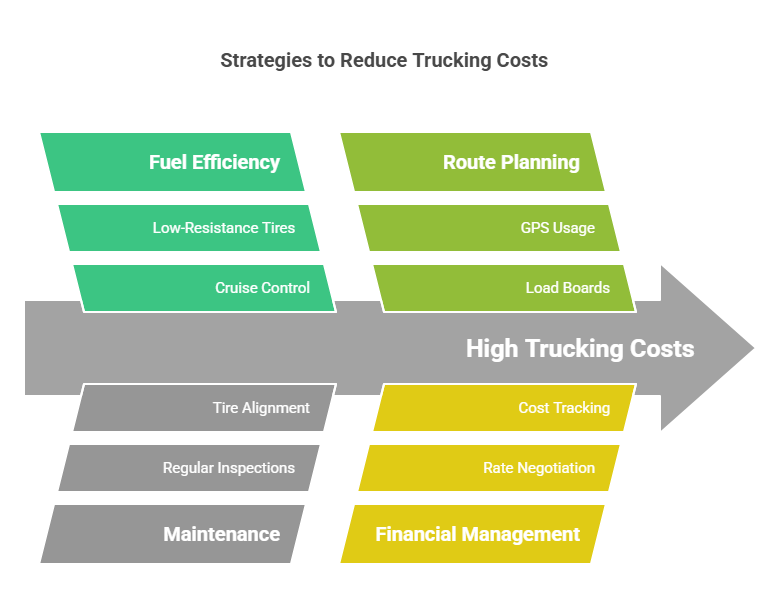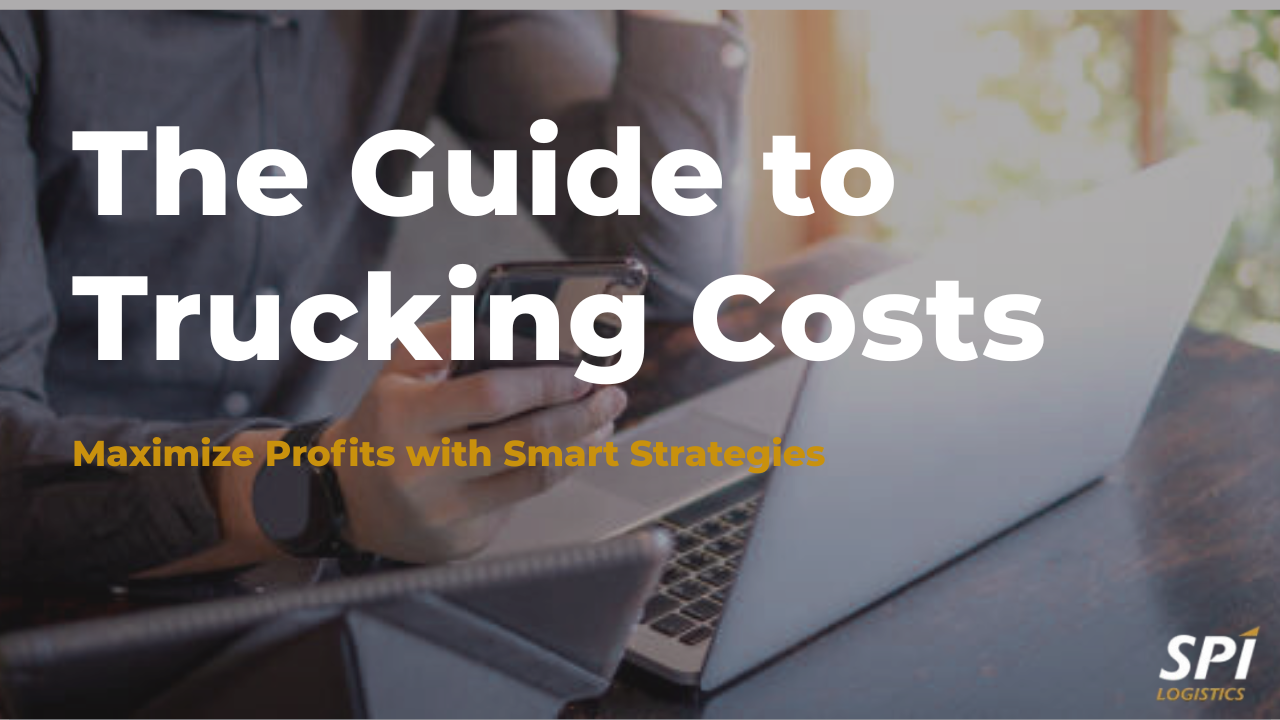Understanding your trucking cost per mile is essential for maintaining a profitable and sustainable operation, especially for owner-operators and small fleet owners. From using a trucking cost per mile calculator to evaluating owner operator rates per mile, this guide breaks down everything you need to make smarter pricing decisions (Truckstop, 2024).
Why Knowing Your Cost Per Mile Matters
Every mile you drive impacts your bottom line. Whether you run a 1 mile truck operation or manage a small fleet, calculating your exact expenses is key to maximizing profitability.
Key reasons to calculate cost per mile:
- Determine your break-even point
- Set competitive and profitable rates
- Budget more effectively
- Understand true business health
Many drivers and owner-operators struggle because they don’t know how to find cost per mile accurately. With this guide, we’ll teach you how to calculate rate per mile trucking and go beyond just guessing your profits.

“Many owner-operators make the mistake of focusing on revenue rather than cost control. Knowing your cost per mile is foundational to staying afloat and scaling profitably.”
How has tracking your cost per mile helped you make better pricing or business decisions?
Core Concepts in Trucking Cost Analysis
When discussing trucking cost per mile, it helps to understand the foundational terms and tools available.
Common Terms:
Cost per mile: This is calculated by dividing your total operating costs by the total number of miles driven.
For example, if you spend $120,000 in a year to operate your truck and drive 120,000 miles, your cost per mile is $1.00. This metric helps you understand your break-even point and is essential for pricing loads accurately.
Rate per mile: This is the amount you charge your customers for each mile driven.
For example, If you haul a load for 800 miles and charge $2,000, your rate per mile is $2.50. Ideally, your rate per mile should always be higher than your cost per mile to ensure profitability
1 mile truck: This term symbolizes a hyper-focus on cost and efficiency per mile. Whether you’re an owner-operator or a fleet manager, treating every single mile as its own cost center helps with optimizing fuel use, scheduling maintenance, and setting accurate rates.
For instance, if you run short urban hauls, your fuel and time cost per mile may differ significantly from long interstate trips.
Owner operator rates per mile: Vary based on market and load type.
For instance, a refrigerated load from Texas to California might pay $2.80 per mile, while a flatbed load in a rural area might only pay $1.90 per mile. Being aware of lane rates and seasonal fluctuations helps in selecting the most profitable routes.
Owner operator trucking rates per mile: Should always exceed your cost per mile. If your cost per mile is $1.50, aim to charge at least $2.00 per mile to ensure a profit margin.
For example, if you’re hauling a 1,200-mile load and charge $2.25 per mile, you bring in $2,700, and with a cost of $1.50 per mile ($1,800), you earn a $900 profit.
“Understanding key financial metrics like cost per mile and rate per mile gives a competitive advantage in today’s volatile freight market.”
Trucking Cost Considerations
A detailed trucking cost breakdown includes both fixed and variable costs. Understanding these helps in calculating your overall trucking cost per mile more accurately.
1. Fixed Costs
- Truck payments: This includes monthly financing or lease payments for your semi truck. For example, a new truck lease might cost $2,000 per month, which directly adds to your fixed monthly overhead (DAT Freight & Analytics, 2024)
- Insurance: Commercial trucking insurance covers liability, cargo, and damage. Annual premiums can range from $8,000 to $14,000 depending on your driving history and cargo type.
- Permits and licenses: These include IFTA permits, IRP registration, and other legal requirements. While some are annual, others require periodic renewal and can total hundreds or even thousands per year.
2. Variable Costs
- Fuel: Often your largest variable expense. If diesel is $4.25/gallon and you get 6 mpg, your fuel cost per mile is about $0.71 (U.S. Energy Information Administration, 2024)
- Repairs and maintenance: Includes routine checks, oil changes, and unexpected breakdowns. Average maintenance cost per mile is $0.15 – $0.20, with annual costs around $15,000 (American Transportation Research Institute [ATRI], 2023).
- Tires: High-quality tires may cost $400 to $600 each, and you’ll need to replace them based on mileage and wear. Proper alignment and rotation also add to this cost.
- Lodging and meals on the road: For long-haul drivers, overnight stays and eating out add up. Even conservative spending of $40/day can add over $1,000/month to your expenses.
3. Revenue-Based Calculations
- Use a truck driver cents per mile calculator to determine how much you’re earning per mile. For example, if you earn $1,800 for a 900-mile run, you’re earning 200 cents per mile.
- Use a trucking cost per mile calculator to see how your total expenses compare against revenue. If you’re driving 100,000 miles and have $120,000 in total expenses, your cost per mile is $1.20.
- Use a rate per mile calculator to evaluate freight offers. A $2,000 offer for 800 miles means you’re earning $2.50 per mile.
4. Market Awareness
- Research owner operator rates per mile in your region and by load type. For example, a flatbed haul in the Midwest might earn $2.20/mile, while a reefer run in winter can fetch $3.00/mile.
- Ensure your owner operator, trucking rates per mile always exceed your cost per mile. If your cost is $1.50/mile, don’t accept less than $2.00/mile.
5. Financial Strategy
- Understand how to find cost per mile by using detailed logs and calculators.
One area often underestimated is truck maintenance cost per mile, which can eat into your profit if not tracked carefully. For example, if maintenance averages $0.15 per mile and you’re driving 10,000 miles per month, that’s $1,500 in monthly maintenance costs alone. Proper tracking and proactive repairs can prevent larger, costlier issues down the road.
These tools and methods not only show you how much to charge per mile, but also highlight areas where you can reduce costs or increase efficiency.

“Preventive maintenance isn’t optional, it’s your first line of defense against costly downtime.”
Which cost category has surprised you the most in terms of its impact on your cost per mile?
Tools to Calculate Trucking Costs
Using the right tools can streamline how you figure out your trucking costs and rates. Here are key calculators every truck driver and owner-operator should be using:
- Truck Driver Cents Per Mile Calculator: This tool converts your total pay into cents per mile. For instance, if you earn $1,200 for a 600-mile trip, your pay rate is 200 cents per mile. It’s useful for comparing job offers or checking efficiency over time.
- Trucking Cost Per Mile Calculator: Use this to input all fixed and variable expenses along with your total mileage. If you input $120,000 in annual expenses and 120,000 miles driven, it shows your cost per mile as $1.00. This helps in understanding your break-even point.
- Rate Per Mile Calculator: Enter the total rate you’re being paid and the number of miles. If you’re offered $1,800 for a 900-mile run, your rate is $2.00 per mile. Use this to evaluate if a load meets your profit goals.
- Fuel Cost Per Mile Calculator: Helps isolate how much of your costs come from fuel. For example, with diesel at $4.50 per gallon and fuel efficiency at 6 mpg, your fuel cost per mile is $0.75. This is essential when fuel prices spike.
- Maintenance Cost Estimator: Use historical repair records to estimate your truck maintenance cost per mile. If you spend $6,000 annually and drive 60,000 miles, that’s $0.10 per mile.
These calculators often come as mobile apps, Excel templates, or online dashboards, making it easy to access them on the road.
How to Calculate Price Per Mile
Follow this simple formula for cost per mile:
Formula for Cost Per Mile:
(Total Expenses) ÷ (Total Miles Driven) = Cost Per Mile
For example, if your expenses are $100,000 annually and you drive 100,000 miles:
$100,000 ÷ 100,000 miles = $1.00 cost per mile
Use a truck driver cents per mile calculator to fine-tune this calculation for real-time decision-making.
“Leveraging online calculators helps eliminate guesswork and gives you confidence in quoting and negotiating.”
Curious how much your operation really costs per mile? Use SPI’s shipping service tools to calculate and compare your rates.
Strategies to Reduce Trucking Costs
Cutting down costs without compromising quality is key to staying competitive. Here are practical strategies:
- Optimize Fuel Efficiency: Use cruise control, minimize idling, and drive at steady speeds. Switching to low-resistance tires and maintaining proper inflation can also reduce your fuel cost per mile (ATRI, 2023).
- Preventive Maintenance: Schedule regular inspections and oil changes to avoid costly breakdowns. Replacing air filters and checking tire alignment regularly can save thousands over time.
- Plan Smarter Routes: Use GPS and load boards to avoid empty miles. More loaded miles means better efficiency and lower cost per mile.
- Negotiate Better Rates: Always track market rates using load boards or rate analytics tools. Being informed helps you get top dollar for your miles.
- Buy Used or Lease Wisely: Consider lightly used trucks with good maintenance records. Leasing may reduce upfront costs, which lowers your fixed expenses.
- Track Every Mile and Dollar: Use spreadsheets or software to track all costs. Knowing how to work out cost per mile down to the penny allows you to cut wasteful spending.

“Savings don’t always come from big moves. Small efficiencies across fuel, maintenance, and routing add up fast.”
What’s one strategy you’ve implemented that made a noticeable difference in your cost per mile?
How to Determine Cost Per Mile
Here’s how to work out cost per mile and build profitable pricing models that sustain your business through market ups and downs:
-
Add all expenses (fixed + variable)
Begin by calculating all your business expenses. Fixed costs include truck payments, insurance, permits, and office overhead. Variable costs include fuel, maintenance, tires, meals, and lodging. This gives you a complete picture of your total operating expenses. The goal is to know exactly what you’re spending every dollar counts. -
Track all loaded and empty miles (true cost basis)
Don’t just track paid, loaded miles. Include empty (deadhead) miles as well. If you only calculate based on revenue miles, you’ll underestimate your real cost per mile. Track total miles driven in a given period this is your true operating mileage and should be the denominator when calculating cost per mile. -
Use a rate per mile calculator to compare industry rates
Once you know your cost per mile, use a rate per mile calculator to set your minimum required rate for profit. Then, compare this with current market rates and if your target rate is too far above the market, look for ways to lower your costs or improve efficiency. -
Learn how to calculate cost per mile for fuel and factor that into your pricing
Fuel is often your largest variable expense. To calculate your fuel cost per mile, divide your total fuel cost by miles driven. For example, if diesel is $4.00/gallon and you average 6.5 MPG, your fuel cost per mile is approximately $0.62. Knowing this helps you adjust rates based on fluctuating fuel prices and improve fuel efficiency where possible. -
Apply what you learn to how to calculate rate per mile trucking
Use all this data to build a custom pricing model that keeps you profitable. Once you know your break-even point, set your rate per mile to include a healthy profit margin typically $0.50 to $0.75 per mile over costs. Factor in market trends, backhaul opportunities, and seasonal changes to ensure consistent earnings.
Real-World Application
Let’s say you run a 1 mile truck route on a local delivery. To remain profitable:
- Use a trucking cost per mile calculator to monitor expenses
- Reassess your owner operator trucking rates per mile regularly
- Reference your truck driver cents per mile calculator weekly
- Understand how to calculate price per mile during different seasons
“Pricing isn’t just about covering your costs, it’s about understanding your market, knowing your value, and building resilience into your business model.”
Looking for better, faster payments that reflect your rates? Discover how SPI Carrier Payments can support your pricing goals.
Frequently Asked Questions (FAQs)
How to determine cost per mile for a 1 mile truck operation?
Use a trucking cost per mile calculator tailored for short hauls. Be sure to include loading time and idling in urban traffic.
What’s the best way to find out how much to charge per mile?
Use a rate per mile calculator and compare it to your cost per mile. Make sure your rate per mile is higher to maintain profitability.
How much do trucking companies charge per mile and how does that compare with owner operator trucking rates per mile?
Trucking companies may charge $2.00+ per mile, while owner operator trucking rates per mile can be higher due to fewer overheads but also less volume.
What’s included in figuring cost per mile and how can I work it out?
Everything from truck maintenance cost per mile to insurance and food. Use a comprehensive owner operator trucking rates per mile calculator to work it out accurately.
How to calculate rate per mile trucking and stay profitable?
Ensure you know your cost per mile using a trucking cost per mile calculator. Then, set your rate per mile above that figure with a comfortable profit margin.
How to charge per mile as a new owner-operator?
Start by learning how to determine cost per mile, then use a rate per mile calculator to ensure you’re not underpricing. Be conservative until you establish market relationships.
What is the cost per mile to operate a semi truck?
On average, between $1.38 and $1.75. This varies based on fuel, maintenance, and type of operation.
Master your Trucking Costs to Drive Profits
Knowing how to calculate dollars per mile, and more importantly, figuring cost per mile consistently, is what separates successful owner-operators from those who struggle. Whether you’re learning how to calculate cost per mile for fuel, how to charge per mile, or just starting to learn how to calculate rate per mile trucking, make sure you regularly review your trucking cost per mile. The road to success starts with understanding the numbers behind every mile.
Ready to take control of your trucking business? Contact us to streamline your operations and start earning what you deserve
References
American Transportation Research Institute. (2023). “An Analysis of the Operational Costs of Trucking 2023.” Retrieved from https://truckingresearch.org
DAT Freight & Analytics. (2024). “DAT iQ Rate Insights.” Retrieved from https://www.dat.com
Truckstop. (2024). “Owner-Operator Profitability Tips.” Retrieved from https://truckstop.com
U.S. Energy Information Administration. (2024). “U.S. Diesel Fuel Prices.” Retrieved from https://www.eia.gov/petroleum/gasdiesel/
.




